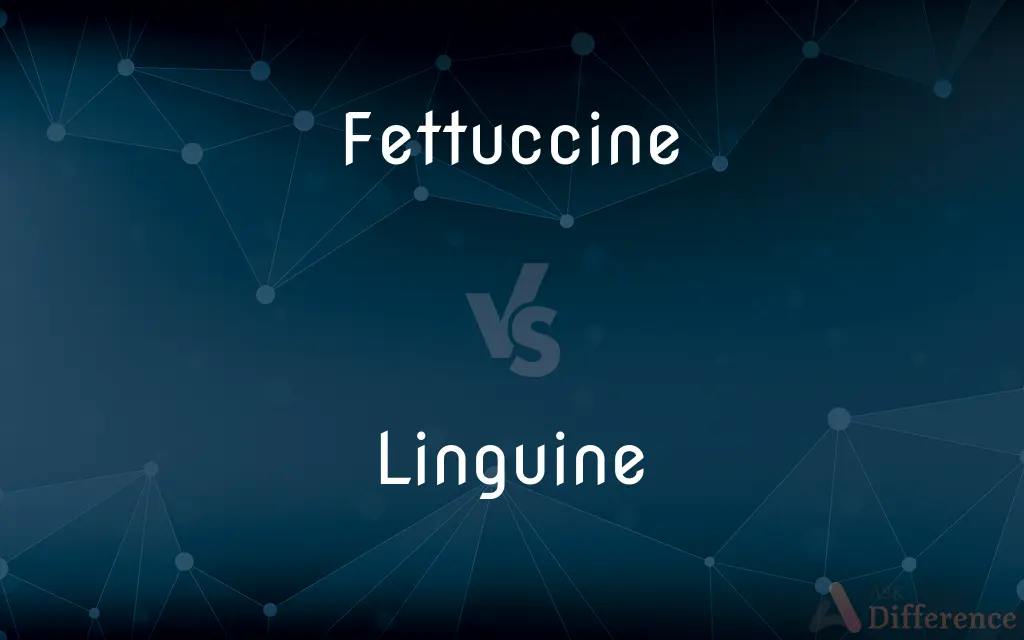Fettuccine vs. Linguine — What's the Difference?
Edited by Tayyaba Rehman — By Fiza Rafique — Updated on October 10, 2023
Fettuccine is a thick, flat pasta; Linguine is narrower and oval-shaped. Fettuccine means "small ribbons" in Italian, while Linguine means "little tongues."

Difference Between Fettuccine and Linguine
Table of Contents
ADVERTISEMENT
Key Differences
Fettuccine and Linguine, both of Italian origin, bear significant importance in diverse pasta dishes. Fettuccine typically appears in Roman and Tuscan cuisine, while Linguine finds its home primarily in dishes from Liguria and Piedmont.
Fettuccine, thick and hearty, is often paired with robust sauces. In contrast, Linguine, being slightly thinner and flatter, is commonly coupled with lighter, often seafood-based, sauces, offering a delicate balance between pasta and topping.
Highlighting culinary traditions, Fettuccine is popularly known for the dish Fettuccine Alfredo, a creamy, cheesy delight. Linguine, on the other hand, stars in Linguine alle Vongole, an elegant dish comprising clams, garlic, and often a splash of white wine.
Navigating through their textures, Fettuccine, being wider, provides a chewier mouthfeel, making it satisfying in meaty or creamy preparations. Linguine, with its streamlined shape, provides a lighter bite, and is consequently cherished with delicate sauces and ingredients.
Reflecting upon regional specificity, Fettuccine may be more prevalent in central Italian cuisines, playing a starring role in Roman and Tuscan kitchens. Linguine is, arguably, more likely to be featured in coastal, particularly Northern, Italian recipes, showcasing sea-fresh ingredients.
ADVERTISEMENT
Comparison Chart
Shape
Thick, flat ribbons
Narrower, slightly oval strands
Name Meaning
"Small ribbons" in Italian
"Little tongues" in Italian
Traditional Sauces
Heavier, creamy sauces
Lighter, often seafood-based sauces
Regional Association
Associated with Rome and Tuscany
Common in Liguria and Piedmont
Popular Dishes
Fettuccine Alfredo
Linguine alle Vongole
Compare with Definitions
Fettuccine
Fettuccine is a type of Italian pasta shaped like flat ribbons.
She prepared homemade Fettuccine for dinner.
Linguine
Linguine prominently features in Ligurian and Piedmontese cuisine.
In Liguria, they savored a traditional dish of Linguine with fresh clams.
Fettuccine
Fettuccine typically pairs with rich and hearty sauces due to its thick and robust nature.
The chef recommended a mushroom sauce for the Fettuccine.
Linguine
Linguine provides a lighter bite, suitable for subtle and elegant sauces.
The shrimp and cherry tomatoes lightly sautéed created a splendid sauce for the Linguine.
Fettuccine
Fettuccine often features in Roman and Tuscan cuisine.
While touring Rome, they enjoyed Fettuccine with a creamy Alfredo sauce.
Linguine
Linguine is a narrow, slightly oval-shaped Italian pasta.
The Linguine with clam sauce was absolutely delicious.
Fettuccine
Fettuccine's width and texture lend itself to substantial, meaty preparations.
The Fettuccine was served with a robust bolognese sauce.
Linguine
Linguine often pairs with lighter, seafood-based sauces due to its delicate structure.
The Linguine was beautifully complemented by a white wine and garlic sauce.
Fettuccine
Fettuccine is often made from a flat sheet of pasta, which is then cut into ribbon-like strands.
She skillfully sliced the pasta dough into perfect Fettuccine strands.
Linguine
Linguine, meaning 'little tongues,' is often used in dishes that require a gentler pasta presence.
The chef used Linguine to subtly carry the flavors of the seafood stew.
Fettuccine
Fettuccine (Italian: [fettutˈtʃiːne]; lit. 'little ribbons'; sing.
Linguine
Linguine (; Italian: [liŋˈɡwiːne]) is a type of pasta similar to fettuccine and trenette but elliptical in section rather than flat. It is about 4 millimetres (0.16 in) in width, which is wider than spaghetti but not as wide as fettuccine.
Fettuccine
Pasta in narrow flat strips.
Linguine
Small pieces of pasta in the form of narrow ribbons.
Fettuccine
A dish made with such strips of pasta.
Linguine
Pasta in long, flat, thin strands.
Fettuccine
Long, flat ribbons of pasta, cut from a rolled-out sheet; identical in form to tagliatelle.
Linguine
Of pasta, cut from a sheet, not as wide as tagliatelle.
Fettuccine
Pasta in flat strips wider than linguine
Linguine
Pasta in long slender flat strips
Common Curiosities
What does "Fettuccine" mean?
Fettuccine means "small ribbons" in Italian.
Which regions predominantly use Fettuccine?
Fettuccine is prevalent in Roman and Tuscan cuisines.
What is Linguine’s Italian meaning?
Linguine means "little tongues" in Italian.
Is Linguine commonly used in Northern Italian cuisine?
Yes, Linguine is notably utilized in the cuisines of Liguria and Piedmont.
How is Linguine shaped?
Linguine is shaped like narrow, slightly oval strands.
What is a classic sauce pairing for Fettuccine?
Alfredo sauce is a classic pairing for Fettuccine.
How is the shape of Fettuccine characterized?
Fettuccine is characterized by its thick, flat ribbon-like shape.
Which seafood dish is Linguine famously used in?
Linguine is famously used in Linguine alle Vongole, a clam dish.
Is Fettuccine suitable for heavy or light sauces?
Fettuccine is generally suited for heavier, robust sauces.
What type of sauces pairs well with Linguine?
Linguine pairs well with lighter, often seafood-based, sauces.
Can Fettuccine be homemade?
Yes, Fettuccine can be made at home by cutting pasta dough into ribbons.
Is Linguine more associated with seafood dishes?
Yes, Linguine is often associated with seafood dishes due to its lighter texture.
Are there whole wheat versions of Fettuccine available?
Yes, you can find whole wheat Fettuccine in stores and recipes for making it at home.
Which is wider, Fettuccine or Linguine?
Fettuccine is wider than Linguine.
Can Linguine be used in vegetarian dishes?
Yes, Linguine can be used in a variety of vegetarian pasta dishes.
Share Your Discovery

Previous Comparison
Penchant vs. Proclivity
Next Comparison
Synch vs. SyncAuthor Spotlight
Written by
Fiza RafiqueFiza Rafique is a skilled content writer at AskDifference.com, where she meticulously refines and enhances written pieces. Drawing from her vast editorial expertise, Fiza ensures clarity, accuracy, and precision in every article. Passionate about language, she continually seeks to elevate the quality of content for readers worldwide.
Edited by
Tayyaba RehmanTayyaba Rehman is a distinguished writer, currently serving as a primary contributor to askdifference.com. As a researcher in semantics and etymology, Tayyaba's passion for the complexity of languages and their distinctions has found a perfect home on the platform. Tayyaba delves into the intricacies of language, distinguishing between commonly confused words and phrases, thereby providing clarity for readers worldwide.














































